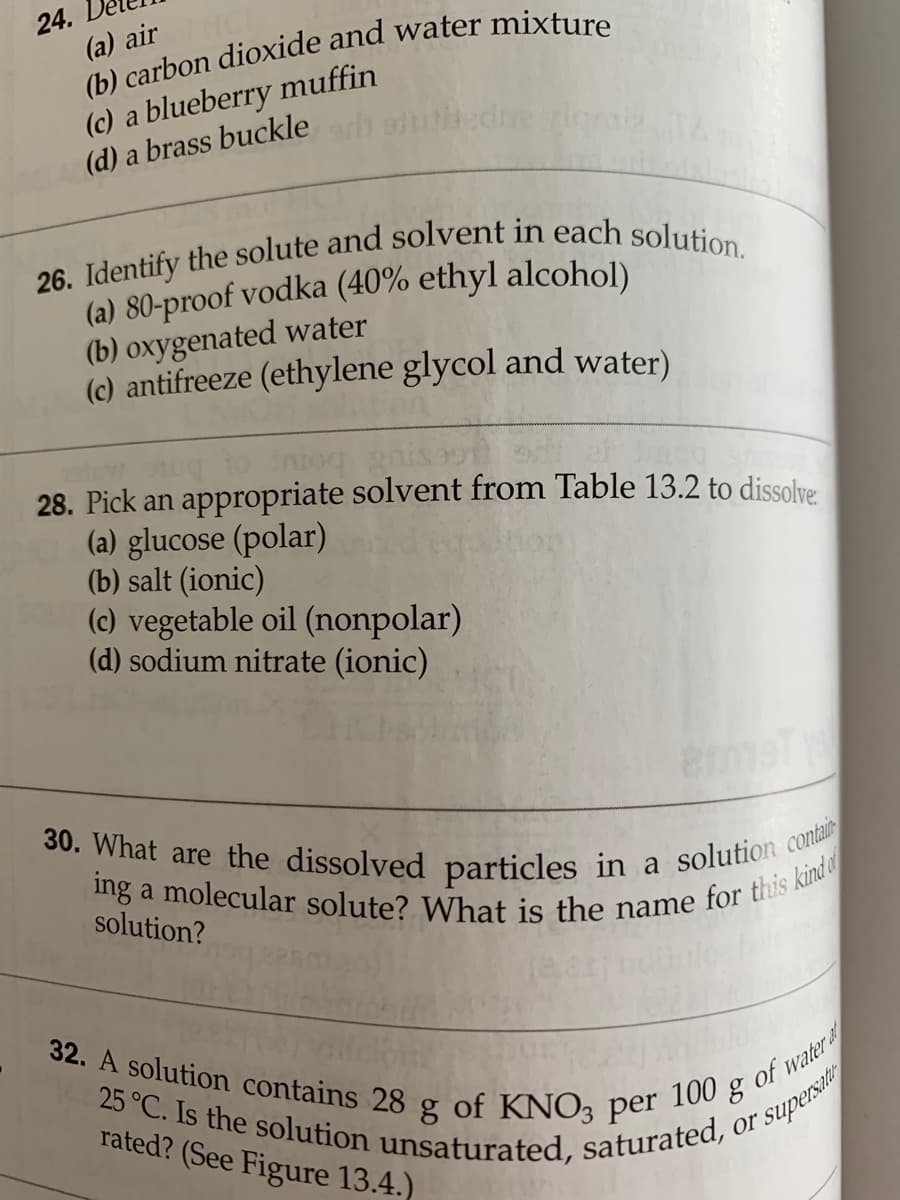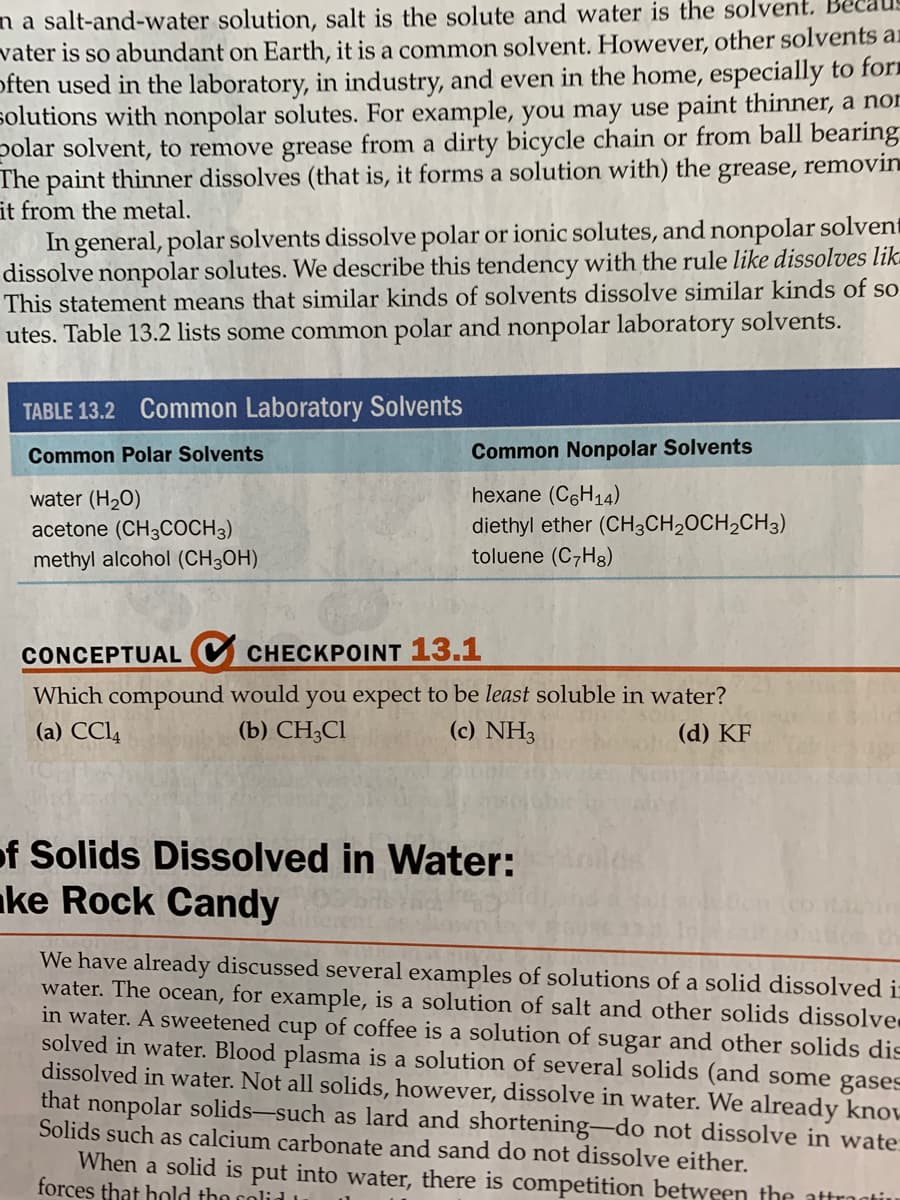28. Pick an appropriate solvent from Table 13.2 to dissolve (a) glucose (polar) (b) salt (ionic) (c) vegetable oil (nonpolar) (d) sodium nitrate (ionic)
28. Pick an appropriate solvent from Table 13.2 to dissolve (a) glucose (polar) (b) salt (ionic) (c) vegetable oil (nonpolar) (d) sodium nitrate (ionic)
Introductory Chemistry: A Foundation
9th Edition
ISBN:9781337399425
Author:Steven S. Zumdahl, Donald J. DeCoste
Publisher:Steven S. Zumdahl, Donald J. DeCoste
Chapter15: Solutions
Section: Chapter Questions
Problem 40CR
Related questions
Question
#28

Transcribed Image Text:ing a molecular solute? What is the name for this kind
32. A solution contains 28 g of KNO3 per
24.
(a) air
30. What are the dissolved particles in a solution contai
25 °C. Is the solution unsaturated, saturated, c
(c) a blueberry muffin
(d) a brass buckle
(a) 80-proof vodka (40% ethyl alcohol)
(b) oxygenated water
(c) antifreeze (ethylene glycol and water)
to intoq
28. Pick an appropriate solvent from Table 13.2 to dissolye
(a) glucose (polar)
(b) salt (ionic)
(c) vegetable oil (nonpolar)
(d) sodium nitrate (ionic)
emet
solution?
a
rated? (See Figure 13.4.)
water a
100
of
or
"supersati

Transcribed Image Text:n a salt-and-water solution, salt is the solute and water is the solvent.
vater is so abundant on Earth, it is a common solvent. However, other solvents ar
often used in the laboratory, in industry, and even in the home, especially to fori
solutions with nonpolar solutes. For example, you may use paint thinner, a non
polar solvent, to remove grease from a dirty bicycle chain or from ball bearing
The paint thinner dissolves (that is, it forms a solution with) the
it from the metal.
In general, polar solvents dissolve polar or ionic solutes, and nonpolar solvent
dissolve nonpolar solutes. We describe this tendency with the rule like dissolves lik.
This statement means that similar kinds of solvents dissolve similar kinds of so
grease,
removin
utes. Table 13.2 lists some common polar and nonpolar laboratory solvents.
TABLE 13.2 Common Laboratory Solvents
Common Polar Solvents
Common Nonpolar Solvents
water (H20)
acetone (CH3COCH3)
hexane (C6H14)
diethyl ether (CH3CH,OCH,CH3)
methyl alcohol (CH3OH)
toluene (C7H3)
CONCEPTUAL O CHECKPOINT 13.1
Which compound would you expect to be least soluble in water?
(a) CCI4
(b) CH;Cl
(c) NH3
(d) KF
of Solids Dissolved in Water:
ake Rock Candy
We have already discussed several examples of solutions of a solid dissolved i-
water. The ocean, for example, is a solution of salt and other solids dissolver
in water. A sweetened cup of coffee is a solution of sugar and other solids dis
solved in water. Blood plasma is a solution of several solids (and some gases
dissolved in water. Not all solids, however, dissolve in water. We already know
that nonpolar solids-such as lard and shortening-do not dissolve in wate:
Solids such as calcium carbonate and sand do not dissolve either.
When a solid is put into water, there is competition between the attrootiu
forces that hold the colid
Expert Solution
This question has been solved!
Explore an expertly crafted, step-by-step solution for a thorough understanding of key concepts.
This is a popular solution!
Trending now
This is a popular solution!
Step by step
Solved in 2 steps

Knowledge Booster
Learn more about
Need a deep-dive on the concept behind this application? Look no further. Learn more about this topic, chemistry and related others by exploring similar questions and additional content below.Recommended textbooks for you

Introductory Chemistry: A Foundation
Chemistry
ISBN:
9781337399425
Author:
Steven S. Zumdahl, Donald J. DeCoste
Publisher:
Cengage Learning

General, Organic, and Biological Chemistry
Chemistry
ISBN:
9781285853918
Author:
H. Stephen Stoker
Publisher:
Cengage Learning

Chemistry: Principles and Reactions
Chemistry
ISBN:
9781305079373
Author:
William L. Masterton, Cecile N. Hurley
Publisher:
Cengage Learning

Introductory Chemistry: A Foundation
Chemistry
ISBN:
9781337399425
Author:
Steven S. Zumdahl, Donald J. DeCoste
Publisher:
Cengage Learning

General, Organic, and Biological Chemistry
Chemistry
ISBN:
9781285853918
Author:
H. Stephen Stoker
Publisher:
Cengage Learning

Chemistry: Principles and Reactions
Chemistry
ISBN:
9781305079373
Author:
William L. Masterton, Cecile N. Hurley
Publisher:
Cengage Learning

Chemistry: An Atoms First Approach
Chemistry
ISBN:
9781305079243
Author:
Steven S. Zumdahl, Susan A. Zumdahl
Publisher:
Cengage Learning


Chemistry
Chemistry
ISBN:
9781305957404
Author:
Steven S. Zumdahl, Susan A. Zumdahl, Donald J. DeCoste
Publisher:
Cengage Learning